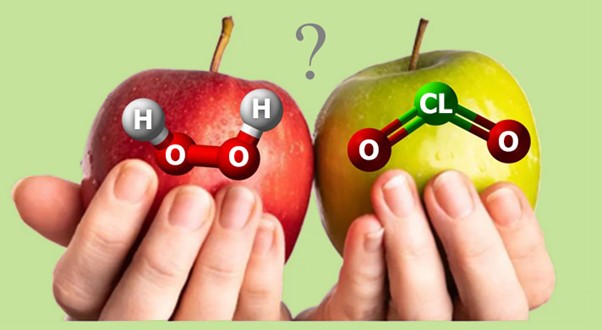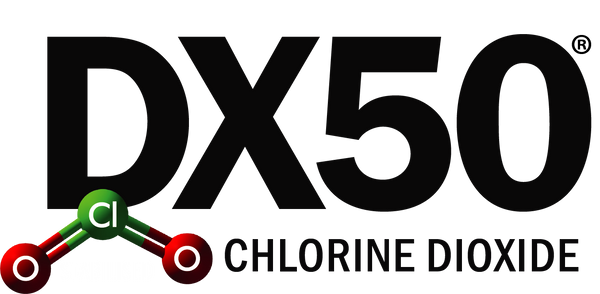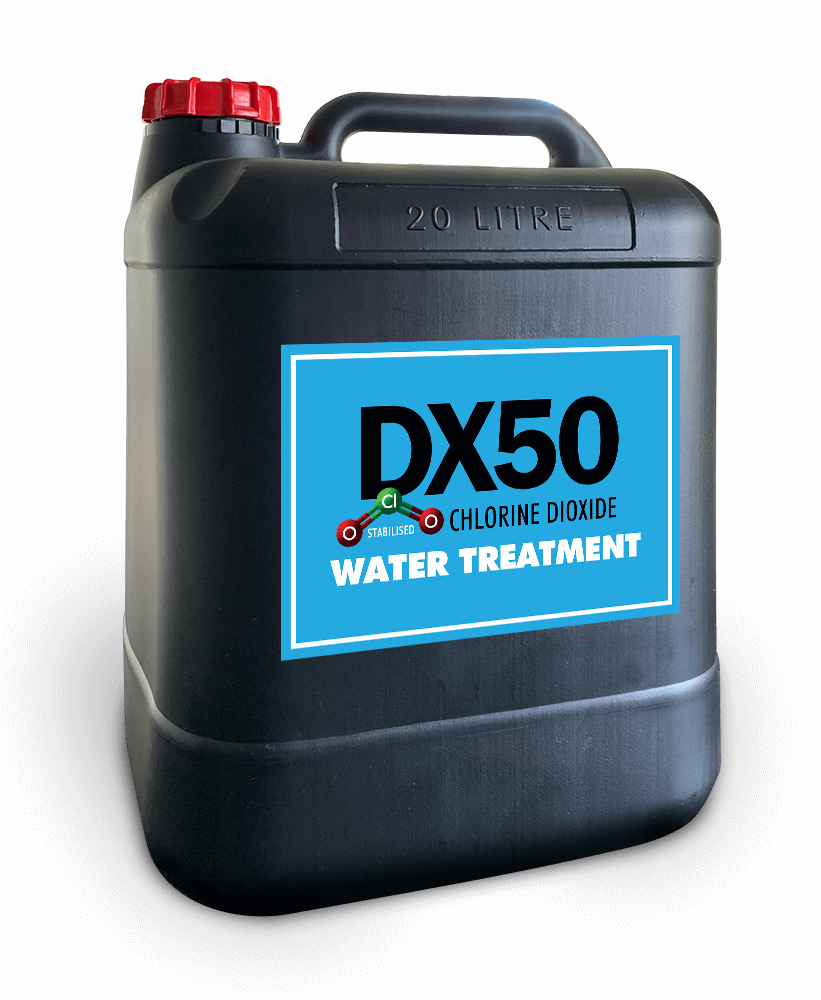
Hydrogen Peroxide vs Chlorine Dioxide: Which Is Greener?
Share
DX50 vs Hydrogen Peroxide: Eco-Friendly Disinfectant Showdown
Similarities: Both are powerful oxidizing solutions
In many ways, both chlorine dioxide and hydrogen peroxide are equally good disinfectants, though there are situations where one will favour over the other.
They are both very powerful and effective oxidizing agents that can be used to disinfect water, and they’re both very effective against a wide range of microorganisms. The preference will come down to the quality of your water source, and how much you can afford.
Chlorine Dioxide:
Chlorine dioxide is a broad-spectrum biocide and effective sanitiser used in many water treatment systems worldwide to destroy organic microorganisms and inorganic contaminants in public drinking water. It is a particularly effective solution for removing biofilm, iron, and manganese.
As a relatively stable compound, chlorine dioxide is commonly used in multiple applications such as food processing, water treatment, bleaching in the paper and textile industries, as a fungicide, mould and odour remover, a sanitiser, in dental hygiene, and more.
Chlorine dioxide may have elemental “chlorine” in it but make no mistake CLO2 is not chlorine. It has one chlorine atom and two oxygen atoms. Much like water has two hydrogen atoms and one oxygen atom. But just as water does not explode, chlorine dioxide doesn’t form the carcinogenic chlorination by-products that chlorine does.
The chemistry is complex (you can Google it), but essentially it is all to do with the electrons and how they react. The reaction disrupts the function of proteins and enzymes in microorganisms, and ultimately kills them. This antimicrobial activity is why chlorine dioxide is so effective against both planktonic and biofilm-forming microorganisms.
It is gaining in popularity over other sanitisers (including chlorine and hydrogen peroxide) because it reacts with specific compounds without reacting with some common water impurities, which can lead taste and odour issues or form harmful byproducts.
Hydrogen Peroxide:
Hydrogen peroxide is a powerful and common household sanitiser and bleaching agent. In higher concentrations it is used by some municipal water treatments as an effective pre-oxidant to improve water quality by removing iron, manganese, sulphides, and cyanides, controlling taste and odour, or assisting in the oxidation of organic and inorganic pollutants.
It is also used as a disinfectant, an antiseptic in medical settings, a bleaching agent in the paper and textile industries, a solution for treating wastewater and industrial effluent, and as an oxygen source in certain environments.
Interestingly, hydrogen peroxide is a faster, more versatile, and more effective disinfectant than chlorine at a wider pH range. It decomposes into oxygen and water, and unlike chlorine it leaves no chemical residues.
However, hydrogen peroxide is considerably more expensive than chlorine and it doesn’t have a lasting residual. For these reasons and others, as we’ll discuss later, the use of hydrogen peroxide to treat drinking water treatment is generally less common than other disinfection methods.
Differences: Stability, Selectivity, Cost
Both chlorine dioxide and hydrogen peroxide seem equally effective, so what are the key differences, and which is the better disinfectant for your specific situation?
Putting specific compound differences aside (see Table 1 below for detailed comparison between CLO2 and H2O2), the most important differences that set the two compounds apart as far as water treatment is concerned are stability, selectivity, and cost-effectiveness.
Stability:

With its two hydrogen atoms and two oxygen atoms, hydrogen peroxide is a simpler molecule compared to chlorine dioxide. It decomposes into water and oxygen so, unless there are compounds that it reacts with, it is unlikely to leave any harmful residues in the water.
However, hydrogen peroxide is relatively unstable and break downs rapidly, especially when exposed to light and heat. This can make it challenging to maintain a residual concentration in the water distribution system, which is important for preventing microbial regrowth.
Chlorine dioxide also breaks down in sunlight, but in a purified water system it can provide a slightly longer residual disinfection than hydrogen peroxide, helping to control microbial growth over time.
To improve stability and performance, some hydrogen peroxide solutions add silver ions. Silver interferes with the cell membrane, proteins, and DNA of microorganisms, and disrupts their structure and function. However, as silver is a heavy metal, its release into the environment can have toxic effects on aquatic life.
Selectivity:

Chlorine dioxide is known for its “selectivity” in oxidation reactions, unlike hydrogen peroxide which has a broader spectrum of reactivity. What this means is that chlorine dioxide is very good at targeting and eliminating specific contaminants, such as bacteria, viruses, and unwanted organic compounds like mould, algae, and fungi, but it doesn’t react with or corrode other substances. This selectivity advantage also makes chlorine dioxide especially good at breaking down and preventing biofilm – the slimy layers of microorganisms that can form on surfaces and equipment.
Hydrogen peroxide on the other hand is not selective and is highly acidic. While it is generally effective against bacteria and algae, it may not be as effective against certain types of pathogens or biofilms. Also, the more compounds that hydrogen peroxide reacts with, the more disinfection by-products are formed, some of which could be potentially harmful.
Hydrogen peroxide isn’t as effective against biofilms, as its action can be influenced by factors such as substrate material and the specific microorganisms present.
Cost Effective:

The efficacy of hydrogen peroxide as a water treatment solution depends on factors such as water chemistry, temperature, and organic matter content. So, when you compare the amount of chemical needed to treat water, the dosing frequency, and t
he corrosion risk, you may find that hydrogen peroxide is a more expensive option than other water treatment solutions.
Also, hydrogen peroxide is highly acidic and comes in a higher chemical concentration than stabilised chlorine dioxide, so the product is a harsher irritant requiring appropriate masks and gloves to handle. Whereas using smaller doses of DX50 stabilised chlorine dioxide presents less exposure and health safety risk when used as directed, uses less product, less storage space, and it costs less too.
Yes, chlorine is the cheapest and most popular option with a long residual, but it’s not a pleasant chemical for taste, odour, corrosion, health and environment reasons. By comparison, chlorine dioxide is a cost-effective alternative disinfectant that selectively kills a wide range of microorganisms without harming the environment, and it leaves the water tasting and smelling fresh.
Moreover, with chlorine dioxide you need a much smaller dose of chemical for treating water than you would with both hydrogen peroxide and chlorine, and you’d get better disinfection results.
So, which is the better disinfectant?
Depending on what water characteristics you have, how your existing system is set up, and what your budget is, both chlorine dioxide and hydrogen peroxide can be effective water treatment solutions.
For example, if your water source is high in sulphide, hydrogen peroxide may be better able to remove it. But if your water system contains algae and other organic and inorganic contaminants, or is contaminated with E.coli and other nasty bacteria, or is suffering from a build-up of stubborn biofilm then chlorine dioxide may be the better option.
We know that cost considerations play a significant role in selecting water treatment methods. Striking a balance between effectiveness and affordability can be challenging. So, for example, if your water treatment system and distribution network is designed for one disinfection method, switching to another solution may involve costly modifications to your existing infrastructure.
To determine which solution is best for your situation, we recommend that you first get your water tested and then talk with a water treatment specialist. You can also contact us to learn more about DX50 Chlorine Dioxide.
Table 1: Comparison between DX50 stabilised chlorine dioxide and hydrogen peroxide
|
Criteria |
Stabilized ClO2 |
H2O2 (Hydrogen Peroxide) |
|
Effective Against |
Broad-spectrum ‘selective’ antimicrobial activity, effective against bacteria, viruses, fungi, algae, and some parasites. It even kills cryptosporidium, giardia, E.coli and legionella. |
Broad-spectrum non-selective oxidant. Kills Bacteria, viruses, algae, some fungi. May not be as effective as CLO2 against certain pathogens. |
|
Resistant Strains |
No resistance strains. Rapidly selective activity - too fast for microorganisms to develop resistance |
No resistance strains. Though, prolonged and continuous use of silver-based antimicrobial agents may contribute to the development of resistant strains of microorganisms. This resistance can reduce the effectiveness of silver-stabilized hydrogen peroxide over time. |
|
Dosage (mg/L) |
Effective at low concentrations, reducing the amount of chemical needed for treatment. Dosage typically 0.1 - 1.0 mg/L. (DX50 recommends 0.75mg/L) In NZ, the maximum allowed concentration of chlorine dioxide in drinking water is no more than 0.8 parts per million (ppm). |
Higher concentration needed for water treatment, which will necessitate more chemical and more storage. Dosage typically 20 - 200 mg/L The US Environmental Protection Agency (EPA) guidelines recommend 25 to 50 parts per million (ppm) of residual H2O2 in drinking water. |
|
Frequency of Application |
Generally less frequent application than H2O2. |
More frequent application than CLO2. |
|
pH Range |
Effective over a broad pH range (4-10), making it suitable for water treatment applications where pH levels may fluctuate. |
pH-dependent, works best in neutral to acidic conditions (3-6) |
|
Temperature Range |
Effective over a wide temperature range |
Less stable at higher temperatures. |
|
Positives |
Effective at low concentration against a broad spectrum of pathogens. Selective reactivity. Effective for removing biofilm, iron, manganese, and for reducing colour and controlling odours. |
Breaks down into water and oxygen. Provides oxygen for biological activity. Effective in removing iron, manganese, sulphides, and cyanides, and controlling taste and odour. |
|
Safety considerations |
DX50 stabilised chlorine dioxide is safe when used as directed. High concentration may cause irritation to the eyes, skin, and respiratory system. |
Concentrated hydrogen peroxide is highly acidic and can be hazardous, so appropriate safety precautions must be taken during storage, handling, and application. At 3% dilution (home use) H2O2 can cause mild irritation to skin and mucus membranes. It is very dangerous if ingested. At concentrations above 7% it can be corrosive to certain materials. This can potentially damage tank components or plumbing infrastructure over time. It's important to use concentrations that are safe for the specific materials in the water system. |
|
Stability |
Less stable than chlorine and breaks down more easily over time. |
Not stable (less stable than chlorine dioxide), breaks down quickly into water and oxygen. H2O2 solutions with added silver-ions will achieve a more sustained residual. |
|
Contact Time |
Short contact time for disinfection and biofilm control. Acts quickly against a broad spectrum of microorganisms. |
Requires a longer contact time for biofilm control. |
|
Lasting Residual |
Short-lived residual in water with organic matter. In purified water it has a longer lasting residual, providing continued disinfection protection downstream. |
Short-lived residual. It decomposes rapidly in the presence of organic or reactive compounds. May require higher doses than CLO2 |
|
Odour and Taste |
Odourless and tasteless in treated water at recommended dosage. |
Odourless and tasteless |
|
Considerations |
Low reactivity with organic matter. |
May not be as effective against certain pathogens. May require higher concentrations for effective treatment. Decomposes faster in the presence of organic matter. May decompose in the presence of certain metals. Higher concentrations may be corrosive; decomposes in sunlight. |
|
Disinfection by-products (DPBs)/ Environment |
May form trace amounts of chlorite ions and chlorate ions. Harmless to the environment. |
Hydrogen peroxide breaks down into water and oxygen, leaving no harmful residual byproducts. However, the use of silver-stabilized hydrogen peroxide may lead to the accumulation of silver residues in the water over time. This can be a concern in terms of environmental impact and potential health effects, as excessive exposure to silver can be harmful. Silver is a heavy metal, and its release into the environment can have toxic effects on aquatic life. |
|
Cost |
Moderate |
Moderate to high. Hydrogen peroxide may be more expensive than some other water treatment options. The cost-effectiveness of using hydrogen peroxide depends on factors such as the required concentration, the volume of water being treated, and the frequency of treatment. |








